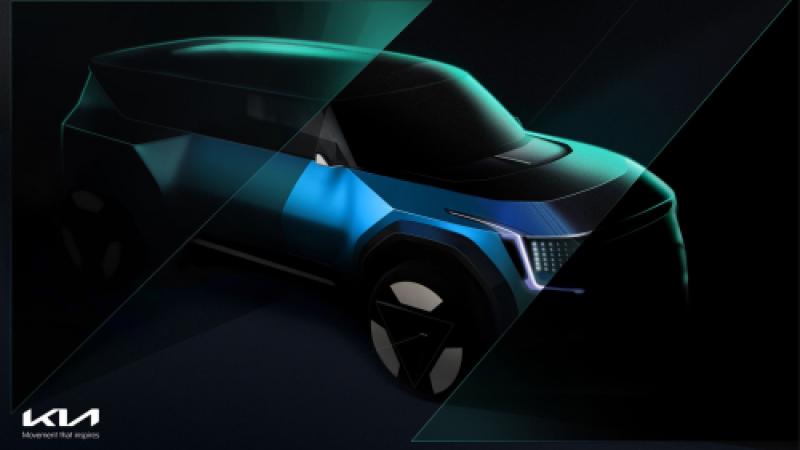At its recent “Kia Sustainability Movement” virtual presentation, Kia Corporation announced a commitment to achieve carbon neutrality throughout its value chain by 2045. Achieving carbon neutrality will be based on three key pillars: Sustainable Mobility; Sustainable Planet; and Sustainable Energy. The pillars will guide Kia in its efforts to reduce carbon emissions in all operational facets, from supply, logistics, vehicle production and vehicle use through to disposal of waste.

By 2045, Kia plans to reduce 97% of the company’s 2019 level of carbon emissions. The company will attain carbon neutrality by implementing additional measures to fully offset its remaining carbon emissions.
Kia also previewed the Concept EV9 ahead of its AutoMobility LA reveal this week. The Concept EV9 hints at Kia’s next model in the dedicated BEV line-up based on the Electric Global Modular Platform (E-GMP) architecture, following in the footsteps of the Kia EV6.
Achieving full electrification in major markets by 2040. The single largest portion of carbon emissions generated by any mass vehicle manufacturer occurs when the vehicle is in daily use and on the road. Kia will thus prioritize the transition from internal combustion engine (ICE) vehicles to a full eco-friendly vehicle line-up. As a result, to achieve zero carbon emissions during the vehicle usage stage, Kia will further accelerate implementation of its mid-to-long term Plan S strategy.
Kia aims to electrify its full vehicle line-up in Europe by 2035. From 2040, Kia’s line-up in key markets around the globe will also exclusively consist of electrified models, realizing zero emissions during daily vehicle use.
Kia is also working with its suppliers to reduce carbon emissions from the parts supply stage. Kia aims to create a carbon emissions monitoring system for its partner companies by 2022 and will provide solutions to its suppliers based on the resulting data. A key element to this plan is the use of green steel, as the steel industry has traditionally been one of the biggest global carbon emitters.
Protecting marine ecosystems and offsetting carbon emissions. Kia will initiate a Blue Carbon project to contribute to preserving the environment instead of just reducing emissions to achieve its carbon neutrality target. The project will focus on marine ecosystems which are one of the most efficient absorbers of carbon.
Blue carbon is carbon absorbed and stored in seaweed and mudflats, effectively diminishing the amount of carbon in the atmosphere.
To boost the amount of blue carbon, Kia will restore and preserve Korea’s coastal wetlands in collaboration with external partners. As a part of the endeavor, Kia plans to discuss specific project opportunities with the Korea’s ministry of Oceans and Fisheries. Korea has one of the most extensive tidal mudflat environments in the world, making it advantageous for an increase in the level of blue carbon.
Kia will also work with The Ocean Cleanup, the non-profit organization developing and scaling technologies to rid the world’s oceans of plastic. To rid the oceans of plastic effectively, plastic waste currently in ocean needs to be cleaned and new plastic should be stopped from entering the oceans. The Ocean Cleanup to this aim developed the Interceptor—a solar-powered, autonomous catamaran that extracts plastic waste from rivers—to be deployed in rivers around the world to prevent plastic trash from entering the oceans.
Going forward, Kia will work with The Ocean Cleanup to create a resource circulation system. Kia will provide material support to the construction of the Interceptors and will utilize plastic waste gathered from the river cleanup process and use the materials in vehicle production. Kia is planning to increase the company’s percentage of plastic re-use to 20% by 2030.
The company also plans to implement plastic recycling processes during the vehicle disposal stage. Once established, the process will increase the re-use percentage of used batteries and plastic. Furthermore, Kia is planning to conduct pilot projects on second-life battery energy storage systems (SLBESS) with external partners from 2022.
Achieving RE100 and zero emissions at all Kia business sites. Kia aims to achieve zero emissions across all aspects of its business—including all production sites—by 2045, after Hyundai Motor Group and its key subsidiaries announced their plan to join the RE100 initiative in July. Climate Group’s RE100 is an initiative to transition to 100% renewable energy in electricity generation.
For Kia’s overseas sites, all electricity will be sourced from renewable energy by 2030; and by 2040 that transition will be complete for all of Kia’s domestic business sites. In line with Kia’s RE100 commitment, Kia’s Slovakia production facility has already turned to 100% green energy in electricity generation.
To help accomplish this goal, Kia will actively transition to solar energy electricity generation for business sites in Korea, US, China, and India.
By continuing to improve the efficiency of production facilities, Kia aims to cut carbon emissions by one percent each year. To realize this reduction, Kia will implement new innovations such as Carbon Capture, Utilization and Storage (CCUS) technology.
Kia will also transition all company fleet vehicles to electrified vehicles by 2030.